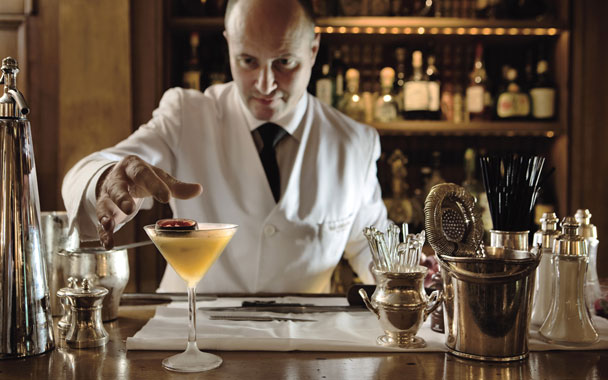This love letter to the legendary bars of some of Paris’s most luxurious (and expensive) hotels is not to suggest that I prefer to lap my gin from Baccarat crystal. And as compelling as I find the cultural lore of early-20th-century Paris, I don’t go to the bar at the Hôtel de Crillon to try to coax Teddy Roosevelt out of the woodwork. If I were only after luxury and history, I’d go read a book in the Louis Vuitton store. The secret is that this cluster of Right Bank monuments holds, and often hides, lounges that provide singular, decadent, theatrical sets for a magical night out in Paris, where opulence and silly fun can go hand in white-gloved hand.
The French have never had a cocktail culture in the Anglo-American vein. Even today, in a French household your hosts are more likely to offer a Kir or vermouth on ice than a Martini before dinner. So the bars américains of the grand hotels—hotels that mostly opened or relaunched in the 1910s and ’20s—catered specifically to that era’s influx of English and American travelers. Some of the palace bars offer fanciful homages to an older version of what a bar should be, a place where there’s a Corpse Reviver on the cocktail list and the barmen all wear bow ties.
At the Ritz’s dark-wood, dozen-table Bar Hemingway, Papa’s preferred rifle is pegged above the bottles and his books line the walls. British head bartender Colin Field, like his book The Cocktails of the Ritz Paris, is a font of fastidious cocktail history (ask him about the Bloody Mary and clear your schedule) and a reliable source of delicious drinks.
I sat down at the bar and Field, to whom it’s best to give free rein, immediately started to hollow out a fresh passion fruit in preparation for the Nautilus, a cocktail in which the fruit’s hull, opened at the top, emptied and filled with freshly blended strawberries and vodka, rises slowly out of a passion-fruit Martini. Two drinks in one, with moving parts. As the passion fruit rose slowly from its bright orange sea, the bar erupted in applause, and Field beamed with the satisfaction of a magician whose assistant has not been sawed in half. The bar may be dedicated to Hemingway, but it’s Field’s stage.
Getting to Bar Hemingway is in and of itself one of Paris’s singular experiences. The Ritz faces the Place Vendôme, but Bar Hemingway hides just inside the back doors to the hotel, at the Rue Cambon. So you have to traverse the entirety of the hotel to reach it, a distance that César Ritz, according to one account, decided to make less interminable by filling it with “beautiful things.” The result is a 120-yard, brightly lit corridor, embedded right and left with glass cases of such “beautiful things” as splayed scarves, mounted pumps, glistening perfume bottles, and a sequined denim jacket. Walking the hallway prefigures the dream you’d have if you read the Air France duty-free catalog on opium before going to bed.
Safely out of the merchandise mirage and just a few blocks south, the Hôtel Le Meurice suggests a different fantasy of bygone cocktail culture. In a reference to the hotel’s historic British patronage (it is mentioned by Thackeray and Dickens), in 2007 Philippe Starck redecorated its Bar 228 as a tobacco-toned Victorian gentlemen’s club—except that he made it brilliantly, subtly glamorous. In place of a roaring fire, dozens of peach-colored votive candles flicker in a glass case; lamps stand on lavender cut-crystal bases; and white roses tower in the corner of the room. If Bar 228 conjures up Rudyard Kipling, it conjures up Rudyard Kipling in a pair of pearl drop earrings and pink lip gloss. No wonder it attracts the Fashion Week set.
Many palace bars open at six, but the humanitarian Meurice starts serving at noon. I showed up wilted one afternoon after a morning trip to the Louvre, and head bartender William Oliveri restored my will to live with a Bullshot—beef consommé, vodka, Worcestershire sauce, and Tabasco. It was salty, bracing, and powerful enough to run for mayor.




 Pinterest
Pinterest


